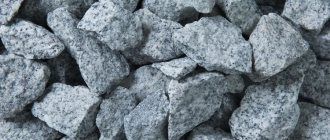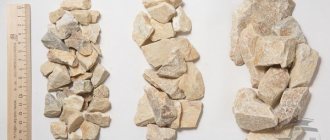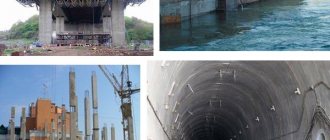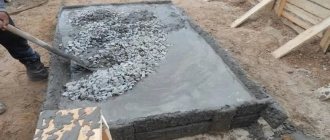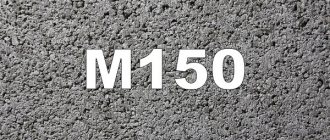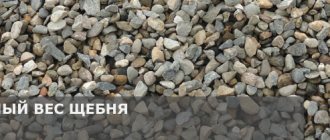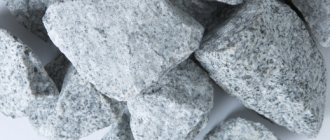- November 21, 2019
- Construction
- Yuliya Grebneva
When producing concrete, various components are used that influence its future technical and operational parameters. These components, in addition to sand, water and cement, include additives - fillers that improve the quality of future concrete.
One of the more reliable aggregates is considered to be crushed stone - a bulk material of inorganic origin, having an irregular shape and size (fraction), resulting from crushing (grinding) large pieces of various rocks. In order to decide which crushed stone is used for concrete, it is necessary to consider in detail its main functions.
Placeholder functions
Being a large aggregate, crushed stone provides a number of advantages for future concrete:
- excellent adhesion to cement-sand mortar;
- a strong frame that will take all the loads of the solution;
- increased strength and elasticity of the solution;
- less chance of shrinkage;
- increase in frost resistance indicators;
- reducing the risk of deformation under load.
In order for future concrete to have high strength, reliability and meet long-term requirements, it is necessary to correctly approach the question of what crushed stone is used for concrete.
There are a few things to consider when choosing an aggregate. This is a classification of crushed stone: types and fractions.
Let's look at the main types used as filler.
Alternative to crushed stone in concrete
In a number of situations, it is possible to use other materials instead of crushed stone as coarse aggregate. What to use instead in concrete?
Here are some options:
- Recycled materials
- Expanded clay
- PGS
- PShchS
Read briefly about each below.
Recycled materials
This group includes materials that are a by-product or have been recycled and can be reused. All of them are suitable as large aggregates for concrete and cost pennies.
This may include the following materials:
- Slag
- Broken brick
- Crushed concrete
- Broken slate
- Broken tiles
Filler made from such materials is suitable for solutions that will be used in household and repair work. They are absolutely not suitable for critical construction. In addition, they have some limitations. Thus, slag concrete is best used for work outside the residential area.
Expanded clay
Expanded clay is optimal for the production of porous or lightweight concrete. This material has high heat and noise insulation characteristics, but low strength. However, private one- and two-story houses are being built from expanded clay concrete blocks. But expanded clay concrete is no longer suitable for the construction of taller buildings.
PGS
The sand-gravel mixture already contains both coarse and fine aggregates. Therefore, it can replace not only crushed stone, but also sand. The disadvantage of the material is that the ratio of sand and gravel can be different, and the grains of the latter have a rounded shape and adhere less well to cement.
Granite
Granite filler, considered the most durable, is a non-metallic material that is extracted from hard rocks (natural granite).
Scope of application:
- construction of roads and laying embankments on railway tracks;
- laying road surfaces and sidewalks;
- construction of reinforced concrete structures;
- production of high-strength concrete;
- construction of walls, floor slabs and columns that experience heavy loads;
- laying the foundation.
Due to the fact that this type is considered the most durable, concrete on granite crushed stone will be the most reliable.
Concrete grades
Concrete mortars are marked with the letter M, which is not identical to its counterpart used to indicate the strength of crushed stone. The most widely used concrete grades are from M100 to M500. This coding takes into account the combined characteristics of all components: sand, cement and crushed stone.
Low-strength concrete grades remain M100-M200. The middle class is represented by M300-350. High-strength products are made from mixtures M400-M500. The correspondence between the grades of concrete and the crushed stone used for their production is given below.
| Concrete, brand | Crushed stone, brand |
| M200 | M800 |
| M300 | M1000 |
| M400-500 | M1200 |
M200
It is used for pouring strip foundations in individual construction or creating a concrete base during road construction. It is permissible to manufacture concrete paths, curb stones, paving slabs, and well rings.
M300
Used to create foundations, monolithic walls, interfloor slabs. The structures have a high load-bearing capacity and are used at airfields (slabs on runways). Suitable for casting load-bearing columns of high-rise buildings and supports of light-loaded bridges.
M400
Concrete of this brand is adapted for structures with specific strength requirements. Serves as a material for the construction of long bridges with high loads, bank vaults, dams and hydroelectric power station foundations. Suitable for use in regions with high seismic activity and significant changes in temperature and humidity throughout the year.
Gravel
This type of crushed stone is obtained by crushing in natural rocks and further sifting the rocks in a quarry.
In turn, crushed gravel is divided into subtypes:
- rounded (under the influence of sea or river water);
- chopped or crushed.
The main areas of application are:
- filling reinforced concrete structures;
- landscape design;
- creation of pedestrian paths and platforms;
- leveling surfaces and embankments.
Crushed gravel concrete is characterized by lower strength compared to granite, and therefore the cost will be less.
Production of self-mixed concrete. Part two: choosing the components of the mixture
In the first part of the article “Making self-mixing concrete,” we talked about the general principles of self-mixing concreting. We also looked at in what cases it is profitable to make concrete yourself, and how to avoid being deceived by concrete suppliers. In the second part of our material, we, based on the experience and knowledge of our portal user Anton Pavlov, will tell you how to choose fillers for self-mixed concrete.
Introduction to self-mixed concrete
At first glance, it seems that preparing “self-mix” is simple. It is enough to use the general construction proportion of 1:3:5, where components such as cement, sand and crushed stone are mixed with water. This is what many builders do. This is where the main pitfall lies.
In the first part of the material, we talked about the importance of maintaining the water-cement ratio.
If the W/C is violated (excess water), the strength of concrete is significantly reduced.
Crushed stone and sand, which are used in “self-mixing”, depending on the construction site, the quarry of their extraction, the time of year and weather conditions, may have different humidity and voidness . That is, using the above averaged formula, and most often, pouring components into the concrete mixer “by eye”, the output we will get is concrete that is completely different from the strength we expected, because the moisture contained in sand and crushed stone, and the percentage of which we did not take into account, also reacted with cement, changed the W/C of the mixture.
High-quality self-mixed concrete begins with calculating the proportions of the mixture in relation to those fillers (their moisture content and voids) that are located at your construction site.
To understand everything, you need to understand what these fillers are needed for.
Fillers for self-mixed concrete
What are crushed stone and sand used for? After all, it is much easier to mix purchased cement with water. Next, pour the mixture into the desired form (formwork), and we will get the necessary concrete structure (lintel, pile, etc.). Not so simple.
AntonpavlovFORUMHOUSE user
Cement (compared to fillers) has a high price. If you fill the mold with cement only, it will cost a pretty penny. If you calculate everything, it turns out that an equivalent volume of cement is several times more expensive than crushed stone and more than 10 times more expensive than sand.
In addition, the strength of concrete is higher if these fillers are introduced into it. Hence: sand and crushed stone make “self-mixing” cheaper, because we save expensive cement. The next question arises: how much sand and crushed stone should be added? To answer this you need to understand the properties of fillers.
There are two types of sand - natural and artificial. We are interested in sand of natural origin. It (depending on the extraction method) comes in three types - river, sea and quarry.
Sand consists of a mixture of grains ranging in size from 0.16 to 5 mm with a bulk density from 1300 to 1500 kg/m³. If we examine sand under a magnifying glass, we will see that each grain of sand has not a strictly cubic, but an arbitrary shape.
Therefore, if you pour sand into any form, then between the grains of sand there will be free space - pores (voids). To make durable concrete, you need to make sure that each grain of sand sticks to each other and all the pores are filled. This “duty” is assigned to the cement paste.
Antonpavlov
Knowing the porosity of sand - the ratio of the volume of its pores (voids) to the volume of grains, we can calculate the required amount of cement, i.e. find the proportion of the mixture.
The size of sand grains is described by the particle size modulus. This module is determined based on the results of the so-called. "sieve analysis", i.e. sifting sand through meshes (holes) of a certain size. Based on the results of sifting, the sand is divided into groups:
- Coarse - sand with a particle size module > 2.5 mm.
- Medium, fineness module - 2-2.5 mm.
- Small, fineness module - 1.5-2 mm.
Sand with a particle size modulus < 1.5 mm is considered very fine. The “fineness modulus” indicator directly affects the water demand of sand and the consumption of cement binder in the concrete mixture.
For self-mixing, sand with a particle size modulus = or > 2.0 mm is best suited.
The function of crushed stone in a self-mixer is similar to the function of sand - reducing cement consumption. Moreover, sand, crushed stone and cement work together. To fill all the voids between the crushed stone, a finer filler is required - sand. Next, the remaining voids in the sand are filled with cement. This way, all the components in the mixture are bound together.
Despite the high cost of crushed stone, it is more profitable to use it than to increase the consumption of cement to fill all the voids.
There are 3 types of crushed stone:
- Granite.
- Gravel.
- Limestone.
Granite crushed stone has the highest strength and frost resistance. Therefore, it is most often used for concreting. In addition, during the production process (during crushing), sharp edges of irregular shape are formed in the crushed stone. Thanks to this, such crushed stone adheres well to the cement mortar, and the stones themselves, due to their lower flakiness, lie more densely. Those. — the number of pores (voids) that need to be filled with sand and cement is reduced.
In the absence of granite crushed stone, crushed gravel stone can be used when concreting. It should be remembered that this type of crushed stone is less durable than granite and, due to the nature of its extraction, the stones themselves have a rounded shape. Such crushed stone deteriorates adhesion to cement and forms a larger number of voids, which, in turn, need to be filled with sand.
As for limestone crushed stone, it should not be used for concreting, because... Such crushed stone is obtained by crushing limestone. Limestone contains calcium carbonate, a water-soluble material. Over time, concrete (working in wet conditions) will lose strength and cavities may appear. This will lead to corrosion of the reinforcement.
So, when concreting with self-mixed concrete, preference should be given to granite crushed stone. The second question arises: what fraction (size of stones) to use.
Antonpavlov
The most common fractions are: 5-20 (stones (grains) ranging in size from 5 to 20 mm) and 20-40 (stones (grains) ranging in size from 20 to 40 mm).
Crushed stone of fraction 20-40 is most often used for concreting foundations (i.e., large structures).
When choosing a fraction of crushed stone for the production of “self-mixing”, you need to take into account the following - the use of self-mixing concrete is justified when pouring structures of relatively small sizes (in comparison with a strip foundation laid below the freezing depth or a slab foundation), i.e. - over-window lintels, reinforced belts, piles for foundations, etc.
Hence: crushed stones (stones) must freely penetrate between the reinforcement bars laid in a limited volume. If we use crushed stone of the “fortieth” fraction, large stones may get stuck between the reinforcement bars. As a result, voids may form in the concrete structure. Crushed stone (stones) of a smaller fraction - “twenties” - on the contrary, will easily fit into the form we require with reinforcement.
We draw the following conclusion: for “self-mixing” it is optimal to use sand with a particle size modulus = or > 2.0 mm and granite crushed stone of fraction 5-20.
In the topic created by Anton Pavlov, you can learn how to independently calculate the proportions of self-mixed concrete, and get acquainted with recommendations for reinforcement, formwork production and concrete care. We also recommend reading the topic, which provides an algorithm for calculating load-bearing walls made of aerated concrete with a density of D300.
FORUMHOUSE has detailed instructions that tell you about all the nuances of concreting at subzero temperatures.
Also watch a video about how high-quality wood concrete blocks are made.
Limestone
Limestone crushed stone is obtained by processing sedimentary rocks of mountain origin and limestone. It is the most accessible and cheapest type of filler.
Scope of application:
- base compactor for road construction (with light load);
- production of reinforced concrete products;
- glass and printing production;
- coarse aggregate for concrete.
Depending on strength, limestone crushed stone can be divided into the following groups:
- M300-600 - the main material in production is limestone;
- M600-800 - a mixture of limestone and dolomite;
- M200 - limited use due to high cost.
Due to the low level of frost resistance (50-100 cycles), crushed limestone cannot be used for capital construction in high latitudes.
Secondary
Recycled crushed stone is a product of processing construction waste: concrete, asphalt or brick.
Despite the fact that this material is inferior in terms of frost resistance and strength to its natural varieties, it is often used as a coarse concrete filler.
The cost of recycled crushed stone can be two times lower than, for example, granite.
Scope of application:
- landscaping;
- strengthening weak soils.
In order to understand which crushed stone is best to choose for concrete, it is not enough to decide only on the type of aggregate; you need to know its types of fractions and the scope of application in each case.
Stages of production of crushed concrete:
- Collection of concrete scrap and selection of raw materials suitable for producing concrete crushed stone;
- Transportation of secondary raw materials to a plant or special site for the production and processing of building materials;
- Grinding of large concrete debris in crushing plants;
- Cleaning from impurities and washing;
- Sorting crushed stone into fractions.
— direct producer of concrete crushed stone. Using our own modern equipment, we crush and clean recyclable materials so that you can buy concrete crushed stone of excellent quality and at a competitive price.
Crushed stone fractions
To decide which fraction of crushed stone is needed for concrete, you need to understand what the difference is between them.
The fraction is understood as the permissible maximum size of each stone (grain).
The higher the fraction number, the larger the stones included in its composition.
Depending on the scope of application, crushed stone with a certain fraction is selected.
Criterias of choice
In order to purchase high-quality crushed stone for concrete, you need to familiarize yourself with the basic selection criteria. The quality of the resulting composition will depend on this.
Fraction
It is important to choose the right gravel or crushed stone - what fraction, to be more precise. The crushed stone fraction is a collection of different particles of approximately the same size in poured concrete. Crushed stone will make up the majority of the entire solution, and, therefore, the quality of the resulting foundation will depend on its characteristics.
Crushed stone for concrete fraction 5-10 mm
Crushed stone added to concrete will minimize the shrinkage process, and also increase the strength characteristics and make the foundation more resistant to loads. The strength of the mortar will depend on the strength of the concrete mixing. This indicator has a direct impact on the density of concrete. To reduce the number of voids formed in the solution, it is necessary to correctly select the fraction of crushed stone and sand. The best option is to use crushed stone of large and small fractions so that the voids between large elements are filled with small particles.
Strength
This includes determining the compressive strength, the degree of crushability of crushed stone within the framework of crushing and the degree of wear. In addition, the amount of weak rocks is determined, the maximum content of which is from 5% to 15%.
Based on the tests carried out, crushed stone is equated to a certain brand:
- high-strength - M1600-1200;
- durable - M1200-800;
- medium strength - M800-600;
- weak strength - M600-300;
- very weak strength - M300 and below.
In the case of use under the foundation, crushed stone grade M1200 is used, which can withstand heavy loads. When determining the grade of crushed stone, you must be guided by the rule: for concrete grade M300, the grade of crushed stone must be no less than M450, and for concrete grade above M300, the grade of crushed stone must be no lower than M600.
Areas and features of application
Most often, concrete on gravel is used for pouring foundations, foundation slabs in private construction, making screeds, and for other monolithic works. But it is not strong enough for the manufacture of load-bearing structures.
Before choosing concrete on gravel, you need to make sure that its technical characteristics are suitable for solving the tasks. The service life and reliability of the constructed facility depend on the correctness of the decision.
Information sources:
- [url] GOST 8267-93
Frost resistance
Allows you to understand within what temperature limits it is allowed to use different types of crushed stone.
Frost resistance is designated as F, and the number following it indicates freezing and thawing cycles (measurement occurs during laboratory tests, which determine exactly how many cycles stone grains can withstand without losing their performance properties).
Within the framework of frost resistance, crushed stone grades are distinguished from F15 to F400. The higher the number, the better the quality of the material.
In the case of use under the foundation of buildings, it is better to use crushed stone marked F250-F300 (granite or crushed gravel).
The main types of crushed stone for concrete and its technical characteristics
Additional components must be added to any concrete mixture, on which the final strength and all important characteristics will depend. To obtain a high-quality composition, it is necessary to use several elements - water, cement and high-quality filler. In most cases, crushed stone for concrete is used as a filler, which has good characteristics suitable for construction. To obtain a high-quality composition, it is necessary to study all the main characteristics of crushed stone, as well as the varieties that can be used.
Flakiness
This characteristic determines the ratio (percentage) of elongated or plate-shaped grains in the entire mass of stones, which are characterized by high strength.
Lamellar particles are characterized by an excess of length relative to thickness by three times, and needle-shaped particles are characterized by an excess of length by three or more times relative to width. In any case, in crushed stone the proportion of lamellar and needle-shaped grains is normalized. In this connection, the flakiness of crushed stone is divided into the following groups:
- Cuboid. The main part of the stones is similar to the shape of a cube; the grains are elongated or flat in shape and range from 10% to 15%. This composition is obtained by crushing granite rocks.
- Improved. Contains from 15% to 25% substandard elements. This type of crushed stone is obtained by crushing large fractions of crushed stone.
- Regular. Contains from 25% to 35% of grains of irregular configuration in the total volume of stones. It is found in the production of crushed stone from limestone rocks.
- Up to 50% of irregularly shaped stones. It is considered a low-grade material, which, for the most part, cannot ensure strong adhesion of the foundation and its solidity. The greater the number of lamellar and needle-shaped grains (the higher the percentage of irregularly shaped stones), the greater the future voids of the solution, and therefore, the higher the consumption of cement in the production of concrete .
If the question arises of what kind of crushed stone is used for high-quality concrete, then we can say that cube-shaped crushed stone is ideal for concrete, as it provides a minimal amount of voids, thereby increasing the quality of the composition and reducing the costs of future concrete.
The cuboid and improved group are considered to have the best characteristics and are used for preparing concrete for the foundation.
When choosing crushed stone, you cannot ignore the rate of its flakiness, since choosing a low-grade option can cause delamination of concrete and loss of its strength.
How to choose crushed stone for specific brands of concrete
Which crushed stone should I choose for the M300 grade? What is better to make concrete M200 from, gravel or granite? We have prepared answers to these and similar questions for you. But first, let's note an important detail.
The characteristics of the same material in different deposits may be different. Even within the same quarry, a stone mined in one place may differ from the same material mined 500 meters later. Therefore, for each batch of crushed stone, their own indicators are always set.
Nevertheless, common features can be identified for crushed stone of one type or another. So, granite will always be stronger than recycled material. If the opposite happens, this is rather an exception to the rule. Therefore, pay attention to the table below.
Crushed stone for specific grades of concrete:
This table will help you get a general idea of what type of crushed stone you should use when making concrete of a certain grade. Let us repeat: it is compiled on the basis of all data on materials in principle and is a consolidated generalized table. It cannot be accepted as truth. And before preparing M300 concrete from limestone crushed stone, check with the supplier for specific characteristics.
And here is an example of the most accurate table of crushed stone for concrete with specific indicators:
It is based on the characteristics of the material we offer for sale. It will help you navigate when choosing crushed stone.
Let's explain how to read the table using examples:
- If you want to get M100 concrete, say, for pouring the floor in a poultry house, choose crushed limestone 20-40. Its performance makes it possible to produce concrete that is strong enough for this work. Plus, by choosing limestone over granite, you'll save money. But before ordering, be sure to check the strength of the material. After all, its performance varies from M400 to M800, and you need the M600 brand.
- The serpentinite variety is suitable for building the foundation of a house. Moreover, all fractions of such crushed stone have excellent strength. If you combine different sizes, the concrete will adhere even better, and the house will last for many decades.
Content of harmful components and radioactivity
The emphasis is on the importance of the absence of impurities in the structure of crushed stone, which are quickly destroyed under the influence of the environment and cement alkalis.
In grades of crushed stone of the highest category, the use of clogging substances such as glass, clay, plastic, broken brick and metal is prohibited.
In crushed stone of lower categories, impurities can account for no more than 7% of the total mass of the filler.
Also, crushed stone must be checked for natural radioactive background.
Production technology
Instructions for making concrete on gravel:
- Preparation of components: removal of impurities, thorough sifting, weighing. The cement is kneaded so that there are no lumps. The gravel is sifted through a sieve to remove particles smaller than 5 mm. Weighing is done using a measuring bucket.
- A mixture of dry ingredients.
- Mixing the mixture with water.
You can also use the second method of preparing concrete - the components are immediately mixed with water, while mixing. The second method is most often used, since it allows you to mix the mixture evenly without leaving dry ingredients at the bottom of the container.
The result should be a mixture of creamy consistency. Color: grey.
Summing up and recommendations
In order to obtain a high-quality and durable solution, you need to follow some rules, thanks to which you can better understand what kind of crushed stone is used for concrete.
- By increasing the density of concrete by introducing fine aggregate, it is possible to increase cement consumption and, as a result, increase construction costs.
- To prepare uniform, high-quality concrete, it is necessary to ensure the cleanliness of the filler (no soil, dust, dirt).
- For better concrete strength during setting, it is advisable to use large fractions together with small ones, which can fill the voids. In this case, the necessary strength and durability will be achieved, and there will be no problems with shrinkage.
- In order to calculate how much crushed stone is needed per cube of concrete, you need to know the technology for making the solution: the mixture for concrete is mixed in a ratio of 1: 3: 5. In other words, for 1 part of cement take 3 parts of sand and 5 parts of crushed stone. For example, for 1 bucket of cement there are 3 buckets of sand and 5 buckets of crushed stone. On the other hand, the required flow rate can be calculated using the formula: Required mass of crushed stone = volume * bulk density. The latter is taken from the quality passport or the corresponding certificate for bulk materials.
- All crushed stone must be completely covered with concrete.
- The filler should be 2-3 grades higher than the planned grade of mortar, which is associated with a long-term increase in the strength and density of concrete (six months, a year or more).
Why do you need crushed stone in concrete?
Crushed stone performs several important functions in concrete:
- It is a kind of frame for smaller components (cement, sand or screenings).
- It does not allow a layer of water to form around small particles, which reduces the strength of concrete.
- The uneven surface of crushed stone contributes to its better adhesion to other components. After hardening, the solution turns into a monolith that will not collapse when exposed to loads of any direction.
- Stone allows liquid to pass through much worse than a simple cement-sand mixture. Therefore, its addition also increases the waterproofing properties.
- Thanks to crushed stone, the concrete structure becomes more elastic, cracks do not appear on it, deformation, creep and shrinkage are reduced.
- The most expensive ingredient in concrete is cement. The price of crushed stone is significantly lower. Adding it to concrete saves a lot of money. At the same time, the strength of the building will not decrease, but, on the contrary, will increase.
The higher the characteristics of crushed stone, the higher they are for concrete. But in order for crushed stone to perform its function 100%, it must meet all state standards.
What happens if crushed stone is used incorrectly?
When adding crushed stone, it is important to maintain proportions. If there is too much of it, it does not adhere well to the cement, and the structure easily disintegrates under the influence of loads. The deficiency leads to subsidence and a decrease in the strength of concrete. The optimal amount is 80% of the total volume of the mixture.
If you buy too expensive material for simple work (installing fence posts, pouring the floor in a poultry house), you will overpay. Yes, your building will be strong, but its operating conditions do not require this. And vice versa: if you buy cheap crushed stone for building a house, you will lose even more. Cracks will soon appear on the walls, and the building itself may simply collapse over time.
Before purchasing, be sure to check all supplier certificates. Study the material carefully and check its characteristics. We will tell you about the properties that are important to pay attention to when purchasing crushed stone for concrete in the continuation of the article.
